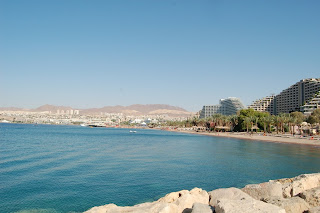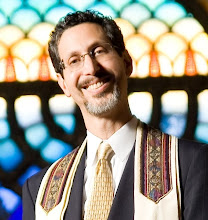
THURSDAY, July 24, 2008
 Our morning was free in Eilat. Many of us found time to walk on the boardwalk or swim in the Red Sea. We were all struck by how full the hotels were, and how few foreign tourists there were. Eilat is the vacation spot for Israeli families and there were kids and young people everyone.
Our morning was free in Eilat. Many of us found time to walk on the boardwalk or swim in the Red Sea. We were all struck by how full the hotels were, and how few foreign tourists there were. Eilat is the vacation spot for Israeli families and there were kids and young people everyone.
After a long walk along Eilat’s beaches, I was able to spend time with my cousin and aunt. It is lovely to reconnect with family whom we see so seldom.
 We were on the road north before noon, traveling up the Aravah, the desert region that reaches from the Eilat to the Dead Sea. To me, it is one of the most majestic and demanding regions of Israel which soaring cliffs and rugged terrain unlike anything I have seen elsewhere. The area is sparsely inhabited with only a few Kibbutzim, including the oldest, Yotvata, and the Conservative movement’s kibbutz Ketura as well as the Reform Movement’s two kibbutzim: Yael and Lotan. We stopped at Lotan to see visit one of our Reform Kibbutzim.
We were on the road north before noon, traveling up the Aravah, the desert region that reaches from the Eilat to the Dead Sea. To me, it is one of the most majestic and demanding regions of Israel which soaring cliffs and rugged terrain unlike anything I have seen elsewhere. The area is sparsely inhabited with only a few Kibbutzim, including the oldest, Yotvata, and the Conservative movement’s kibbutz Ketura as well as the Reform Movement’s two kibbutzim: Yael and Lotan. We stopped at Lotan to see visit one of our Reform Kibbutzim.
After lunch at the Kibbutz we began our tour. Member David Schoenveld was our guide. David told us about the kibbutz’s commitment to environmental living and Reform Jewish Zionist values. Here they teach and they live a commitment to the Earth and our stewardship of it. Out of the harsh environment – the Arava is one of the driest areas on Earth and the temperature when we were visiting was 104 degrees Fahrenheit – community has created an agricultural wonder. They export dates to much of the Arab world and provide dairy milk for the products produced at Yotvata.
 But it is to environmentally conscious living that Lotan is dedicated. We toured the “Bustan Neighborhood” the kibbutz has built; a set of adobe huts built igloo style although supported by a metal geodesic dome and covered in mud and straw. We toured the surprisingly cool interior of
But it is to environmentally conscious living that Lotan is dedicated. We toured the “Bustan Neighborhood” the kibbutz has built; a set of adobe huts built igloo style although supported by a metal geodesic dome and covered in mud and straw. We toured the surprisingly cool interior of  one of these huts and watched as workers and volunteers worked on two new huts. As they describe it the neighborhood "combines natural building, green energy, water saving techniques,
one of these huts and watched as workers and volunteers worked on two new huts. As they describe it the neighborhood "combines natural building, green energy, water saving techniques,  organic edible gardening, education, permaculture design and common sense." David also told us of the “Green Apprenticeship” program the kibbutz has which offers college level credits for work on environmental studies.
organic edible gardening, education, permaculture design and common sense." David also told us of the “Green Apprenticeship” program the kibbutz has which offers college level credits for work on environmental studies.
David also showed us a project JNF has initiated to create an artificial wetland in the desert. He noted that one of the primary bird migratory routes between Africa and Europe passes over Israel and the wetlands around Eilat were a bird resting place. Much of those wetlands are lost now to development, so there is experimental work to create artificial marshes in the desert. These are also being used to filter the wastewater of the kibbutz for reuse.
Our visit to Lotan was short but very inspiring.
From Lotan we continue north to the Dead Sea. Along the way we noticed the very low levels of the southern sea and all the mining that is taking place there.
 Our hotel at the Dead Sea, the Daniel, is one of the nicest we have visited so far. We checked in and quickly changed and hiked a short distance to the Dead Sea itself. There we laughed and floated, as one is supposed to do. The minerals felt oily on our skin but we left with a bit of a glow – and some Dead Sea Salt to take home.
Our hotel at the Dead Sea, the Daniel, is one of the nicest we have visited so far. We checked in and quickly changed and hiked a short distance to the Dead Sea itself. There we laughed and floated, as one is supposed to do. The minerals felt oily on our skin but we left with a bit of a glow – and some Dead Sea Salt to take home.
After a sumptious buffet dinner in the hotel, we turned in for an early evening. Many of us are preparing for a very early morning hike up the “snake path” to see the sun rise from the plain of Massada.
 Our morning was free in Eilat. Many of us found time to walk on the boardwalk or swim in the Red Sea. We were all struck by how full the hotels were, and how few foreign tourists there were. Eilat is the vacation spot for Israeli families and there were kids and young people everyone.
Our morning was free in Eilat. Many of us found time to walk on the boardwalk or swim in the Red Sea. We were all struck by how full the hotels were, and how few foreign tourists there were. Eilat is the vacation spot for Israeli families and there were kids and young people everyone.After a long walk along Eilat’s beaches, I was able to spend time with my cousin and aunt. It is lovely to reconnect with family whom we see so seldom.
 We were on the road north before noon, traveling up the Aravah, the desert region that reaches from the Eilat to the Dead Sea. To me, it is one of the most majestic and demanding regions of Israel which soaring cliffs and rugged terrain unlike anything I have seen elsewhere. The area is sparsely inhabited with only a few Kibbutzim, including the oldest, Yotvata, and the Conservative movement’s kibbutz Ketura as well as the Reform Movement’s two kibbutzim: Yael and Lotan. We stopped at Lotan to see visit one of our Reform Kibbutzim.
We were on the road north before noon, traveling up the Aravah, the desert region that reaches from the Eilat to the Dead Sea. To me, it is one of the most majestic and demanding regions of Israel which soaring cliffs and rugged terrain unlike anything I have seen elsewhere. The area is sparsely inhabited with only a few Kibbutzim, including the oldest, Yotvata, and the Conservative movement’s kibbutz Ketura as well as the Reform Movement’s two kibbutzim: Yael and Lotan. We stopped at Lotan to see visit one of our Reform Kibbutzim.After lunch at the Kibbutz we began our tour. Member David Schoenveld was our guide. David told us about the kibbutz’s commitment to environmental living and Reform Jewish Zionist values. Here they teach and they live a commitment to the Earth and our stewardship of it. Out of the harsh environment – the Arava is one of the driest areas on Earth and the temperature when we were visiting was 104 degrees Fahrenheit – community has created an agricultural wonder. They export dates to much of the Arab world and provide dairy milk for the products produced at Yotvata.
 But it is to environmentally conscious living that Lotan is dedicated. We toured the “Bustan Neighborhood” the kibbutz has built; a set of adobe huts built igloo style although supported by a metal geodesic dome and covered in mud and straw. We toured the surprisingly cool interior of
But it is to environmentally conscious living that Lotan is dedicated. We toured the “Bustan Neighborhood” the kibbutz has built; a set of adobe huts built igloo style although supported by a metal geodesic dome and covered in mud and straw. We toured the surprisingly cool interior of  one of these huts and watched as workers and volunteers worked on two new huts. As they describe it the neighborhood "combines natural building, green energy, water saving techniques,
one of these huts and watched as workers and volunteers worked on two new huts. As they describe it the neighborhood "combines natural building, green energy, water saving techniques,  organic edible gardening, education, permaculture design and common sense." David also told us of the “Green Apprenticeship” program the kibbutz has which offers college level credits for work on environmental studies.
organic edible gardening, education, permaculture design and common sense." David also told us of the “Green Apprenticeship” program the kibbutz has which offers college level credits for work on environmental studies.David also showed us a project JNF has initiated to create an artificial wetland in the desert. He noted that one of the primary bird migratory routes between Africa and Europe passes over Israel and the wetlands around Eilat were a bird resting place. Much of those wetlands are lost now to development, so there is experimental work to create artificial marshes in the desert. These are also being used to filter the wastewater of the kibbutz for reuse.
Our visit to Lotan was short but very inspiring.
From Lotan we continue north to the Dead Sea. Along the way we noticed the very low levels of the southern sea and all the mining that is taking place there.
 Our hotel at the Dead Sea, the Daniel, is one of the nicest we have visited so far. We checked in and quickly changed and hiked a short distance to the Dead Sea itself. There we laughed and floated, as one is supposed to do. The minerals felt oily on our skin but we left with a bit of a glow – and some Dead Sea Salt to take home.
Our hotel at the Dead Sea, the Daniel, is one of the nicest we have visited so far. We checked in and quickly changed and hiked a short distance to the Dead Sea itself. There we laughed and floated, as one is supposed to do. The minerals felt oily on our skin but we left with a bit of a glow – and some Dead Sea Salt to take home.After a sumptious buffet dinner in the hotel, we turned in for an early evening. Many of us are preparing for a very early morning hike up the “snake path” to see the sun rise from the plain of Massada.




1 comment:
Dear Rabbi Cahana,
I would like to thank you once again for making time in your busy schedule to come visit us here in the desert. Although it was short, I truly enjoyed guiding you here on Kibbutz Lotan. It is groups like yours that make a difference in spreading the word of what Reform kibbutzim are doing in Israel. I hope to see you and members of your congregation again on Lotan and in Israel.
Sicnerely,
David Schoneveld
Licensed Tour Guide
Kibbutz Lotan
Post a Comment